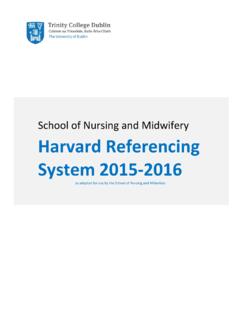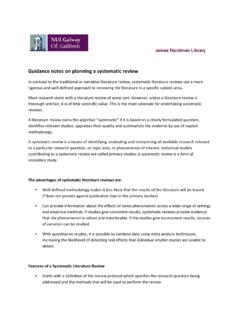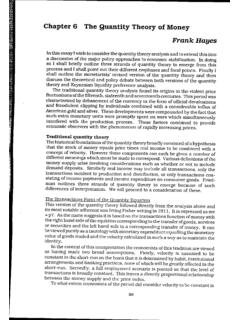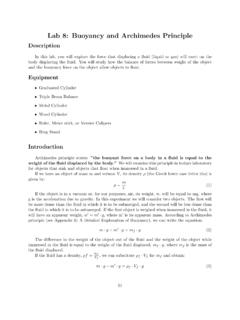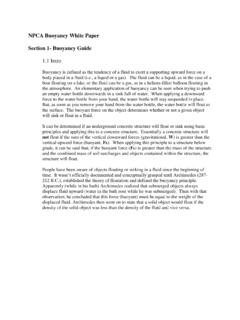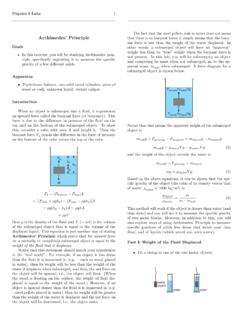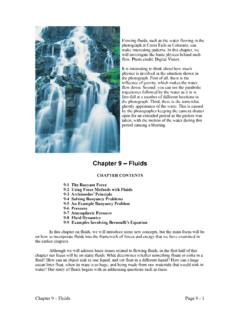Transcription of Buoyancy Archimedes Principle Fluid flow Viscosity
1 Lecture 8. Buoyancy Archimedes Principle Fluid flow Viscosity Buoyancy and Archimedes Principle One's body ,arms and legs etc, feel lighter under water. Easy to lift someone if they are in a swimming pool. Archimedes Principle : Any object completely or partially immersed in a Fluid experiences an upward or buoyant force equal to the weight of the Fluid it displaces. Archimedes (287 BC 212 BC). Greek Physicist, Mathematician Buoyant force easily explained Pressure is greater at greater depth: P = rgh F1. therefore the upward force is greater at the bottom of an object than the downward F2.
2 Force at the top of the object F2 > F1. Net upward force is the buoyant force is equal to the weight of the displaced Fluid . Buoyancy and Archimedes Principle Cube of same Fluid Buoyant force Fb Fb = P2A2- P1A1. h1 P1A1 Cube remains stationary h2. Fb = weight of Fluid = weight of Fluid mg P2A2 displaced P1 = rgh1 Fb = P2A2- P1A1= mfg P2 = rgh2 where mf =mass of Fluid Cube of different material (only mass of cube changes) buoyant force remains unchanged (Fb = mfg). Fb = mfg =rfluidVfluidg If an object floats then the buoyant force must equal its weight.
3 If an object sinks then its weight must be greater than the buoyant force. Buoyancy and Archimedes Principle 0 0. wobject - Fb wobject Fluid Apparent weight = net downward force = wobject - Fb Fb = weight apparent weight Fb = weight of liquid displaced Buoyancy and Archimedes Principle Calculate the volume and density of an Irregular shaped object. Example A person has a mass of 75kg in air and an apparent mass of 2kg when submerged in water. Calculate the volume and density of the person. Fb = weight apparent weight mass of water displaced = Mass apparent mass mass of water displaced = 75kg 2kg = 73kg Volume of water displaced =(mwater)/(rwater).
4 = 73kg/1000kgm-3 = 73x10-3m3. Therefore volume of person = 73x10-3m3. rperson =(mperson)/(volumeperson). rperson =(75kg)/(73x10-3m3) = 1027kgm-3. Viscosity and Fluid flow One characteristic of fluids is that they flow Fluid flow in tubes: examples: IV tubes, garden hoses, circulatory system Flow rate Q defined as volume flowing per unit time (V/t). Q = (V/t). SI units: m3 per second Flow rate depends on pressure difference other characteristics of the Fluid and tube Viscosity and Fluid flow Q = (V/t). Flow rate depends on pressure difference P1 P2 P1 = P2 no flow P1 > P2 flow direction L.
5 P1 < P2 flow direction P1 P2. Flow rate Q . R. where R is the resistance to flow. Resistance is all factors that impair flow; example, friction between Fluid and tube, friction within the Fluid *. * known Viscosity h (Greek letter eta). SI unit of Viscosity Viscosity and Fluid flow Flow can be characterised as laminar turbulent Turbulent flow Fluctuating flow patterns Caused by constrictions or obstructions Turbulence causes increased resistance to flow Viscosity and Fluid flow Laminar flow Smooth, streamlined, quiet Resistance to laminar flow of an incompressible Fluid in a tube is a function of tube length (L), 8h L.
6 Radius (r) R 4. Viscosity h r 1. R 4 double radius; resistance decreases by a factor of 16. r Viscosity and Fluid flow 8h L P1 P2. R 4 Flow rate Q . r R. r4 . Q ( P1 P2 . 8h L . Poiseuille's Law French scientist Jean Poiseuille (1797-1869). studied Fluid flow in tubes; in particular blood flow Viscosity and Fluid flow Fluid flow Teeth Sensitivity to cold, heat, air, Concerned with Fluid flow within the tooth Fluid flow dentinal tubules (microscopic channels). radiate outward through the dentine from the pulp to the dentine-enamel interface.)
7 If outer enamel develops a crack or cavity when you eat cold food, for example normal Fluid flow within the dentine may be disrupted affecting the pulp (nerves , blood vessels etc), resulting in pain. Viscosity and Fluid flow To change flow rate; change radius of tube Examples Blood flow rate in circulatory system changed by constricting or dilating blood vessels Clamp on IV tubing Tap on garden hose Flow rate Q. r4 . Q ( P1 P2 Q r4. 8h L . If effective radius of a vein or artery is reduced by a constriction (deposits). blood circulation problems occur.)
8 Result: heart has to work considerably harder to produce a higher blood pressure in order to maintain the required flow rate. Viscosity Materials Resistance to Fluid flow Dentistry Restorative materials are manipulated in Fluid state to achieve desired result Viscosity of cement should be low so that it will flow over tooth surface to achieve good retention Materials Prepared as Fluid pastes adapted to the required shape subsequently solidify Setting of such materials Change of Viscosity with time Viscosity Restorative Dental Material Initial low Viscosity for dispensing and moulding.
9 Followed by large increase in Viscosity during setting Working time time during which the material can be easily manipulated (low Viscosity ). Setting time time at which Viscosity becomes very high Change of material Viscosity with time Viscosity Viscosity Viscosity Time Time Time No well defined Well defined long Long working time working time or working time and reasonable setting time sudden setting time setting time Viscosity and Fluid flow Example If effective radius of the artery is halved, by what factor does the blood flow rate change?
10 R 4 . r4 . Q0 ( P1 P2 Q ( P1 P2 . 2. 8h L 8h L .. Q 1 1 Q0. 4 . Q0 2 16 Q . 16. Factor of 16. Viscosity and Fluid flow Example By what percentage would the radius of the arteries have to decrease to reduce the blood flow rate by a factor of 3. r4 Q0 rn4 . Q0 ( P1 P2 ( P1 P2 . 8h L 3 8h L . Dividing the two equations Q0 r 4 1 rn4. ( P1 P2 . n 3 8h L . 4. 3 r r4 . Q0 ( P1 P2 1 r 8h L 4 n 3 r rn Reduction of ( )x100% = 24%. Viscosity and Fluid flow Example Patient receiving blood transfusion through a needle of length and radius The reservoir supplying the blood is above the patients arm.))))))


